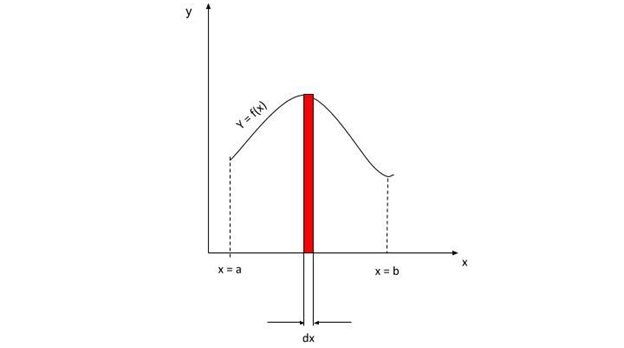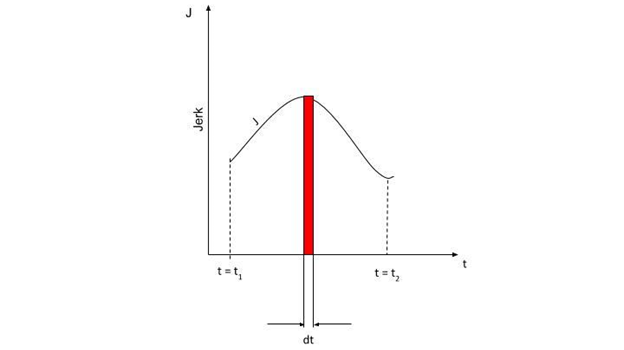
The quantity jerk, J, is defined as the time derivative of an object's acceleration,
$J = \dfrac{{da}}{{dt}} = \dfrac{{{d^3}x}}{{d{t^3}}}$
What is the physical meaning of the area under a graph of jerk versus time.
A) The area represents the object's change in acceleration
B) The area represents the object's acceleration
C) The area represents the object's change in velocity
D) The area represents the object's velocity
Answer
219k+ views
Hint: When we are talking about an area under a curve, we are talking about performing integration operations on a curve, the integration can be performed with respect to either x-axis or y-axis. Consider the following figure for understanding his concept.

In the above figure the area under the entire curve can be found by calculating the area of the rectangle which is painted red and integrating it between the limits a to b. The area of the rectangle (dA) is equal to the product of height (y = f(x)) and width (dx).
$dA = ydx = f\left( x \right)dx$
$A = \int_a^b {f\left( x \right)dx} $
Complete step by step answer:

In the given question we have been provided with the definition of the quantity called jerk (J) as the time derivative of acceleration i.e.,
$J = \dfrac{{da}}{{dt}}$.......................(1)
Nw, the figure given above shows the graph of jerk vs. time. Hence, now the area (A) under the curve is given as,
$A = \int_{{t_1}}^{{t_2}} {Jdt} $
From equation (1), put the value of J in above equation
$A = \int_{{t_1}}^{{t_2}} {\dfrac{{da}}{{dt}}dt} $
$A = \int_{{t_1}}^{{t_2}} {da} $
$A = {a_{{t_2}}} - {a_{{t_1}}}$
Where, and are accelerations at time $t_1$ and $t_2$ respectively. So now we can say that,
$A = \Delta a$
i.e. area under the jerk vs. time curve is equal to the change in acceleration.
Note: One can easily get confused by applying the logic of integration and derivative, getting cancelled by each other as these operations are opposite in nature and say that the answer to this question will be acceleration and not the change in acceleration. However, it should be noticed that for definite integral the answer will be change in acceleration whereas for indefinite integral we will get acceleration as a function of time.

In the above figure the area under the entire curve can be found by calculating the area of the rectangle which is painted red and integrating it between the limits a to b. The area of the rectangle (dA) is equal to the product of height (y = f(x)) and width (dx).
$dA = ydx = f\left( x \right)dx$
$A = \int_a^b {f\left( x \right)dx} $
Complete step by step answer:

In the given question we have been provided with the definition of the quantity called jerk (J) as the time derivative of acceleration i.e.,
$J = \dfrac{{da}}{{dt}}$.......................(1)
Nw, the figure given above shows the graph of jerk vs. time. Hence, now the area (A) under the curve is given as,
$A = \int_{{t_1}}^{{t_2}} {Jdt} $
From equation (1), put the value of J in above equation
$A = \int_{{t_1}}^{{t_2}} {\dfrac{{da}}{{dt}}dt} $
$A = \int_{{t_1}}^{{t_2}} {da} $
$A = {a_{{t_2}}} - {a_{{t_1}}}$
Where, and are accelerations at time $t_1$ and $t_2$ respectively. So now we can say that,
$A = \Delta a$
i.e. area under the jerk vs. time curve is equal to the change in acceleration.
Note: One can easily get confused by applying the logic of integration and derivative, getting cancelled by each other as these operations are opposite in nature and say that the answer to this question will be acceleration and not the change in acceleration. However, it should be noticed that for definite integral the answer will be change in acceleration whereas for indefinite integral we will get acceleration as a function of time.
Recently Updated Pages
Two discs which are rotating about their respective class 11 physics JEE_Main

A ladder rests against a frictionless vertical wall class 11 physics JEE_Main

Two simple pendulums of lengths 1 m and 16 m respectively class 11 physics JEE_Main

The slopes of isothermal and adiabatic curves are related class 11 physics JEE_Main

A trolly falling freely on an inclined plane as shown class 11 physics JEE_Main

The masses M1 and M2M2 M1 are released from rest Using class 11 physics JEE_Main

Trending doubts
JEE Main 2026: Application Form Open, Exam Dates, Syllabus, Eligibility & Question Papers

Understanding Uniform Acceleration in Physics

Derivation of Equation of Trajectory Explained for Students

Hybridisation in Chemistry – Concept, Types & Applications

Understanding the Angle of Deviation in a Prism

Understanding Collisions: Types and Examples for Students

Other Pages
JEE Advanced Marks vs Ranks 2025: Understanding Category-wise Qualifying Marks and Previous Year Cut-offs

Units And Measurements Class 11 Physics Chapter 1 CBSE Notes - 2025-26

NCERT Solutions For Class 11 Physics Chapter 8 Mechanical Properties Of Solids

Motion in a Straight Line Class 11 Physics Chapter 2 CBSE Notes - 2025-26

NCERT Solutions for Class 11 Physics Chapter 7 Gravitation 2025-26

Understanding Atomic Structure for Beginners




